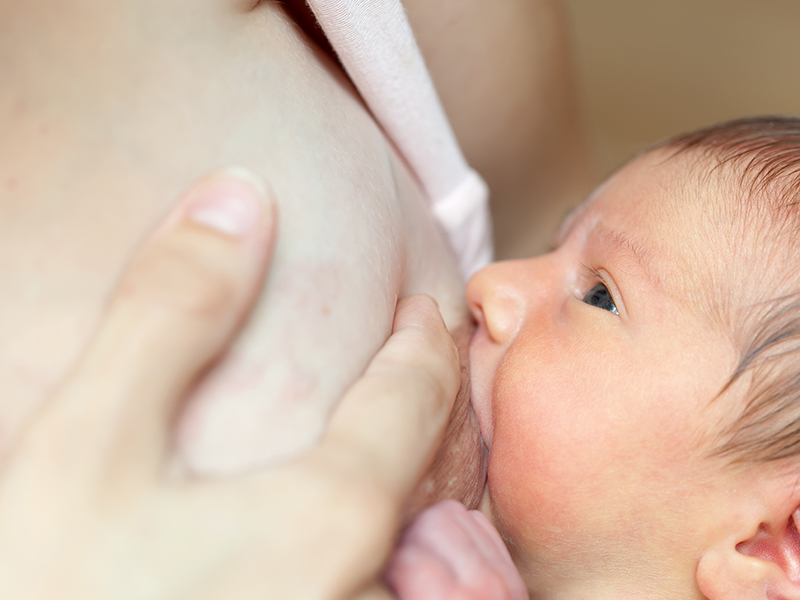Breastfeeding brings along a lot of changes for new moms. The fluctuation in breast size as your body starts to make colostrum and mature milk is normal but will leave you feeling tender and sore. These changes along with the physical act of breastfeeding will be overwhelming at first. If you know what to expect, it’s easier to take good care of your breasts and avoid or manage any problems that might arise.
In conversations with TC46, Lactation Consultant Arushi Agrawal shares causes of pain while breastfeeding, nursing issues every mom should know about and ways to take better care of your breasts.
Breastfeeding For New Moms
Breastfeeding is beneficial to both you and your baby, but it can be difficult on your nipples! It’s a roller-coaster ride and we’re going to make it easier for you by giving some beneficial tips and tricks so keep reading to learn more.
Causes Of Nipple & Breast Pain While Breastfeeding

When a baby is learning to nurse, latching on to the breast can take more time and effort. The nipple can become irritated and sensitized as a consequence of the friction. The nipple can also dry out, resulting in broken skin and bleeding at times.
Take the example of sore or broken lips caused by the wind or the sun. The more you wet them by licking, the drier and bruised they become, you need to moisturize to soothe, calm, and heal them. Your nipples are the same way.

A shallow latch is one of the most common reasons for nipple injury which further leads to painful breastfeeding. Your baby’s ability to get all the milk available is strongly dependent on how well he is attached to the breast. If he doesn’t latch effectively, he cannot remove milk well from the breast. Ideas about how to get your baby to attach well to the breast have been evolving in recent years. The basic objective is to get the mother’s breast and nipple positioned deeply in the baby’s mouth.
Today, skilled counsellors understand and believe that there is no one right way to do this and that a mother must follow the “correct” procedure, like a recipe. At one time there is no single correct way for a baby to latch to the breast. The only essential measures of a good latch are that mother and baby are comfortable and that milk transfers efficiently.
It is normal to feel some tenderness in the early days, but if it actually hurts, he is probably latched too shallowly. Encourage a deeper latch by changing your position or the way he comes to the breast. If the pain continues, something is wrong no matter how good the latch may look on the outside; seek help from a lactation consultant sooner rather than later. If the baby isn’t latching successfully by the end of the first six hours, keep him skin to skin to stimulate his feeding reflexes and begin expressing colostrum. Don’t use your pump quite yet, though; hand expression usually gets more out than a pump in the beginning. It also works well if your breasts become uncomfortably full as the milk comes in because pumping can draw more fluid into your areolas, which causes swelling.
Certain Issues To Take Into Account While Nursing

- Breast Engorgement: When your transitional milk starts to come in on the third or fourth day after birth, your breasts can swell and fill with fluid, transforming them from heavy to humongous. This can be painful and cause discomfort for the first few weeks.
- Clogged Milk Ducts: Breast milk is formed in the breast and passes out the nipple through milk ducts. Milk can back up and cause a tiny, tender lump if one of those ducts becomes clogged. This can in turn lead to breast infections.
- Mastitis: Mastitis, or a breast infection, occurs when bacteria infiltrate the breast through a crack in the nipple or one of the milk ducts (either through the skin’s surface or via your baby’s mouth). Swelling, discomfort, and redness, as well as a warm breast and a fever, are its symptoms.
8 Vital Nipple & Breast Care Tips

- Even at night, wear a supportive bra. Make sure it’s comfortable and not too tight. Nursing bras make feeding a task easier.
- Avoid tight clothing and underwire bras, which can clog milk ducts and raise the risk of infection in the breasts.
- Nursing pads should be changed if they become damp, dirty, or sullied.
- Shower at least once a day to stay away from skin infections. On the nipples, only use clear water. Avoid using soaps as it strips off the natural lubricant created by the glands surrounding your nipples, causing them to dry out and crack.
- Consult a lactation consultant or discuss with your doctor if you feel that the pain is not going away and it is unnatural. After all, they say breastfeeding is a wonderful thing.
- Get your latch checked if your baby is biting, nipping or nibbling. This is a bad sign and it doesn’t go by the time your baby grows, it just keeps getting worse. And not to mention the nipples get traumatised by such an experience.
- Keep your breasts moisturized. There are creams in the market that are specially formulated to be used on the breast while nursing, they are safe and can be used with the right prescription.
- You must maintain a consistent feeding schedule. You should strive for 8–12 feedings a day. This helps to minimize engorgement while still establishing a balanced routine for your newborn.
Easy to do breast tightening exercise at home, Do check it out.

